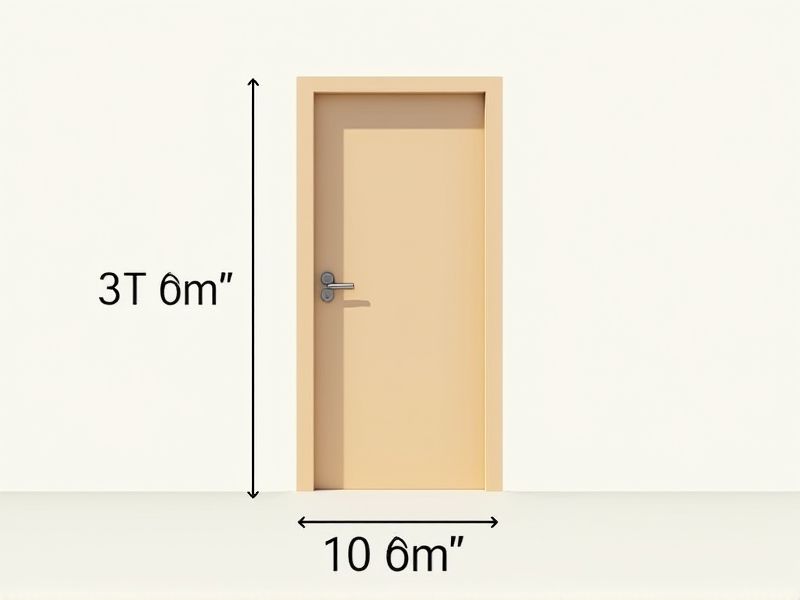
When choosing a front door, it's important to know that the standard dimensions typically range from 36 inches wide by 80 inches tall in the United States. Some homes may have doors that are slightly narrower (such as 32 or 34 inches wide), but 36 by 80 inches is the most common measurement you'll encounter. Measuring the existing doorway frame is essential to ensure a proper fit, especially if you're upgrading or replacing a door. Keep in mind that custom or older homes may have unique sizes, so always double-check your specific requirements before purchasing a new front door.
Width: 32 To 36 Inches
The standard front door width ranges from 32 to 36 inches, ensuring a comfortable entryway into your home. A width of 36 inches is particularly beneficial for wheelchair accessibility, complying with ADA (Americans with Disabilities Act) requirements. Most residential doors measure 80 inches in height, providing ample space for various door styles that enhance curb appeal. Selecting a front door within this width range not only improves functionality but also increases the overall aesthetic value of your property's exterior.
Height: 80 Inches
The standard height for a residential front door is typically 80 inches, providing ample space for most individuals to enter comfortably. This measurement ensures a balance between aesthetics and functionality in home design. When selecting a door, consider that a height of 80 inches allows for proper clearance, minimizing the risk of bumping the head in entryways. Upgrading to custom sizes is possible, but 80 inches remains the preferred choice for a seamless fit in most home styles.
Thickness: 1 3/4 Inches
A standard front door typically measures 1 3/4 inches in thickness, providing enhanced durability and security for your home. This thickness is ideal for energy efficiency, offering better insulation against environmental elements. A solid, thick door can significantly reduce noise pollution, contributing to a quieter living space. Investing in a high-quality, 1 3/4-inch thick front door not only enhances curb appeal but also increases the overall value of your property.
Clearance: Minimum 36 Inches In Front
The standard measurement for front door clearance is a minimum of 36 inches, ensuring adequate space for accessibility and ease of movement. This clearance accommodates various needs, such as wheelchair access, making your entrance more universally friendly. Ensuring this minimum distance can also enhance safety, allowing for unobstructed entry during emergencies. For optimal function, consider maintaining this clearance from any permanent fixtures, such as light fixtures or furniture.
Ada Compliance: 32-Inch Clear Width
A front door that complies with ADA standards requires a minimum clear width of 32 inches to ensure accessibility for individuals with disabilities. This width facilitates the smooth passage of wheelchairs and mobility devices, promoting inclusivity in residential and commercial spaces. The door should also feature a threshold height of no more than 1/2 inch to accommodate individuals with limited mobility. Meeting these specifications ensures that your entrance is both functional and accessible for everyone.
Rough Opening: 38 X 82 Inches
The rough opening for a standard front door typically measures 38 x 82 inches, providing ample space to accommodate various door styles. This measurement ensures a proper fit, allowing for an installation that is both functional and aesthetically pleasing. When planning your door installation, it's crucial to account for the additional framing and insulation materials needed around the rough opening. A precise rough opening is essential, as it influences the overall energy efficiency and security of your home.
Door Frame Depth: 4 9/16 Inches
A standard front door typically features a door frame depth of 4 9/16 inches, which is essential for ensuring proper fit and insulation. This dimension allows for the installation of weather stripping, enhancing energy efficiency by minimizing air leaks. When selecting a front door, consider that this frame depth accommodates a variety of door styles and materials, including fiberglass, steel, and wood. Ensuring your door meets this industry-standard depth will enhance both security and aesthetic appeal in your home.
Material Variability: Wood, Steel, Fiberglass
Front doors come in a variety of materials, each offering distinct benefits for your home's security and aesthetic appeal. Wood doors, popular for their classic look and insulating properties, typically require regular maintenance and can cost between $500 to $2,500 based on the type and finish. Steel doors, known for their durability and resistance to dents and weather, can average around $200 to $800, making them an economical and secure choice. Fiberglass doors provide an excellent alternative with low maintenance needs and energy efficiency, generally ranging from $300 to $2,000, depending on design and insulation features.
Doe Standards: Energy Efficiency Considerations
The Department of Energy (DOE) has established stringent standards for front doors that emphasize energy efficiency, ensuring homes retain optimal temperatures and reduce energy consumption. A front door meeting these criteria typically features a minimum R-value of 5 for insulation, effectively minimizing heat transfer. In addition, the door should be equipped with weatherstripping to prevent air leaks, which can account for up to 30% of heating and cooling energy loss in a home. Choosing a front door that complies with DOE standards not only enhances your home's energy efficiency but can also lead to significant savings on utility bills over time.
Style Options: Paneled, Flush, Glass Inserts
Front doors offer various style options to enhance your home's aesthetic, with paneled, flush, and glass insert designs being highly popular. Paneled doors typically feature multiple raised sections, providing a classic and sophisticated look, while flush doors present a smooth, contemporary surface ideal for modern architecture. Glass inserts can be incorporated into either style, allowing natural light to filter through and offering customizable designs to suit your preferences. Selecting a door that complements your overall home style not only boosts curb appeal but also adds value to your property.
